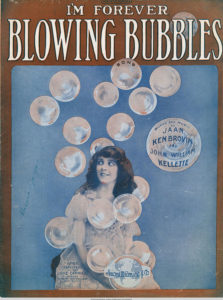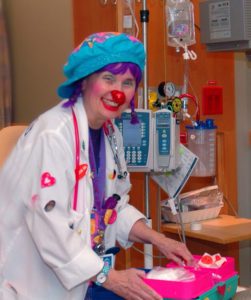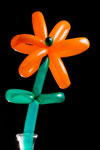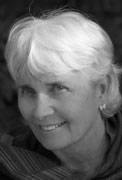
DIVING IN THE MOON
HONORING STORY, FACILITATING HEALING
Bubbles
© Shirley Routliffe
 The woman slumped in the wheelchair in front of the picture window. A blue knitted hat covered her hairless head. She was draped head to foot in a blue hospital issue blanket. Fluffy white slippers with rabbit ears covered her feet. Sunlight streamed through the window and the woman, head bowed, seemed oblivious to her surroundings. Tiny bubbles, “rainbowed” by the sunlight, swirled around her. The woman remained motionless. The bubbles continued to rise and fall bouncing gently onto her knee, grazing a shoulder, leaping playfully off the window ledge.
The woman slumped in the wheelchair in front of the picture window. A blue knitted hat covered her hairless head. She was draped head to foot in a blue hospital issue blanket. Fluffy white slippers with rabbit ears covered her feet. Sunlight streamed through the window and the woman, head bowed, seemed oblivious to her surroundings. Tiny bubbles, “rainbowed” by the sunlight, swirled around her. The woman remained motionless. The bubbles continued to rise and fall bouncing gently onto her knee, grazing a shoulder, leaping playfully off the window ledge.
After a time, ever so slowly the woman’s arm rose from her lap and extended palm upwards. A bubble perched briefly on her hand held its shape before a tiny spattering of droplets took its place. The arm began to move among the bubbles catching one, poking one, swatting several. The bubbles kept coming. Masses of bubbles – little ones, big ones, odd shaped ones – each a perfect rainbow as it floated into the path of the sun.
Fatigued, perhaps from her effort, the woman’s arm lay once more in her lap. She turned her head slightly to one side raised two fingers in salute and with a small but distinct smile turning up the corners of her mouth she straightened in her chair, leaned back with a very deep sigh and tilted her face to the sun.
Two months later, a letter arrived at the hospital addressed to the therapeutic clown.
Dear Toby,
I hope this letter reaches you. You won’t remember me. I know you see a lot of people. A few months ago I was in the hospital. The day before I was discharged, I was feeling very sorry for myself. I was sitting in a wheelchair by the window in Ward 8C. A thoughtful aide must have parked me there. Suddenly, I became aware of bubbles. I was surrounded by them and the sunlight was turning them into rainbows. I hadn’t even noticed the sun! I wanted to pretend at first that I didn’t see them but they kept coming and I was a child again holding my father’s hand.
When I was a child one of my favorite things to do was to blow bubbles. My dad would take me to the park often and we would take the magic bubble mix Mom made with us.
 The cancer really scared me. I feel more comfortable with it all now and the turning point was what I am now calling my bubble reminder day. Thanks for being there to help me remember three things I know to be true
The cancer really scared me. I feel more comfortable with it all now and the turning point was what I am now calling my bubble reminder day. Thanks for being there to help me remember three things I know to be true
1. Enjoy what you have in the moment because it can disappear in a “pop”.
2. Don’t take yourself or life too seriously – remember to play.
3. Attitude is everything.
One never really knows if something we say or do helps another. I want you to know that your presence was just what was needed for me.
Thank you for keeping the bubbles going.
Margery
Toby put the letter in the red pocket of her rainbow overalls and smiled. She remembered that day and she remembered Margery. It had been Toby’s first day on the Ward and she had been so unsure of herself. Margery’s two fingered salute had given Toby the courage to risk engaging other patients that day.
I have told this story many times to friends, to potential therapeutic clowns at the clown school I ran for several years, and to medical personnel. The reactions were always positive. Stories like this one helped the skeptics among the medical personnel see the value of the arts in the healing process and understand that healing didn’t have to mean cure. It might mean a change in perception or a moment of connection where there had been isolation. This particular story gave the novice clowns courage to take more risks, to trust themselves and the process. Clowns are not there to entertain, although they are often entertaining. They are there to make heart to heart connection with another human being if only for a moment.
Healing is not always a one-way street. In the incident with Margery our brief connection gave me courage and enabled me to approach other patients in a more open-hearted manner with less concern for my own comfort level.
Another incident happened in a nursing home for infirm nuns. Unbeknownst to me, a sister in her late 90’s had some dementia and for several years made no eye contact and made virtually no response when spoken to. Nobody had heard her utter a word. Carrying a red balloon into her room, my clown character sat beside her bed and took her hand. At first there was no response. Suddenly her hand left mine and reached for the red globe.” Her face lit up as she said in an audible voice “balloon” – who knows what memory was kindled for this woman?
Clowning Around
I was doing a residency in counseling at Queens University in Kingston Ontario. Our counseling center had been approached by Social Services and the Children’s Aid Society and Youth Probation Services. Their idea was that we would take a group of twelve young people between the ages of twelve and eighteen and work with them in a group setting. The agencies wanted to create a neutral territory for these young people where none of the people working with them would have authority of one kind or another over them. We would not be responsible for placements or for giving them money or for checking up on them in any way.
I was in my early thirties, with two small children and was not particularly interested in teenagers. As a matter fact, I thought I’d be terrible with them. I was low person on the totem pole in our organization so I didn’t have a choice. My major concern was the big gap between twelve and eighteen. I felt that the older kids would be in a very different place from the younger ones and it would be hard to work with them in the same group. No one paid much attention to my worries.
I was to work with the group for two to three hours a week for twelve weeks. We were assigned a room at the University. Four of the students lived in group homes. One young man was on the ward in the psychiatric hospital which is across the street from the University and he would have a pass to come to the group. Two of the youths had been in juvenile detention. The remainder had a variety of issues that had led them to contact with the police and social services. They were still living at home.
The first meeting I hoped we would be able to get to know one another and I had arranged for simple communication games in order to facilitate that.
I placed chairs in a circle before they arrived. I had cookies and juice out which they devoured in the first five minutes. For most of the first meeting half of the kids sat with their backs to the rest of us. One sat in the corner of the room on the floor. So much for my communication games… I struggled for two hours with ideas for conversation… used jokes…finally acknowledged that it must be hard for them to be there when it was mandatory. They didn’t know me. Why would they trust me?
 At the end of the two hours I could hardly wait to get out of there. What was I going to do with these kids? One girl said as she was leaving “Boy, that was the longest two hours I’ve ever spent!”
At the end of the two hours I could hardly wait to get out of there. What was I going to do with these kids? One girl said as she was leaving “Boy, that was the longest two hours I’ve ever spent!”
I looked at her. “Yes, for me too “I agreed. A few people laughed and we all left.
I had been invited the following week to a two day Clowning workshop given by a Quaker from the U.S. I had wanted to attend a workshop for a long time, so this seemed like a great opportunity. I would, however, have to miss the last part of the workshop on the second day to go back to my group. We worked on developing our clown characters and we learned how to make balloon animals. I had spent the better part of the week wracking my brain and talking to anyone who would listen about what to do with my group. I felt discouraged, hopelessly inadequate.
I left the workshop with little time to spare before my group was to start. I took handfuls of balloons, the long skinny kind and filled the pockets of my oversized overalls, figuring I would practice and might teach my boys. I didn’t have time to remove my make-up. I just ran for the car and headed to the university. l really did not want to see these kids and was annoyed at having to leave the workshop.
Most of the group had already arrived. They were sitting most of them without any interaction with others. When I walked into the room one of the girls said “What the heck are you supposed to be?”
“A Clown,” I responded, feeling annoyed and ridiculous at the same time. I was wishing I had taken the time to remove the costume. I put the balloons on the table without comment. Without a comment, everyone started to blow up and twist balloons. A sixteen year old made butterfly wings, put them on and danced around the room. Nobody laughed at her. They cheered her on. Someone made a bow tie, another antlers. Soon we had several dogs, a giraffe and then someone made a hat and put it on my head.”A clown should have a hat.” I wore it the rest of the meeting and home.
Most astonishing to me was that the group began to talk. They talked about what it was like to live in a group home, to have been abused by an uncle, to be locked up in the psych hospital, to be afraid, to know you were smart but know that others did not think so. They talked about their social workers, the good cops and the bad cops, about a Dad in jail and a Mom on drugs.
We were all surprised to see how fast the time had gone. As they left, all twelve made some kind of physical contact with me, a touch on the arm, a pat on the back or a poke at my hat and from two of them – a quick hug.
“Well that was good “announced the girl with the butterfly wings on her way out the door “What are you going to do for an encore?”
For the next ten weeks we played. The first thing we did was have each young person create a space for themselves in the room. We used pillows, blankets, ropes, cardboard. They made signs: keep out… welcome… enter at your own risk. The rule they wanted was no going in anyone’s space without permission. If you wished, you could stay in your space for the entire meeting time. Nobody ever did.
For nearly 3 months nobody, including cleaning staff, disturbed these safe spaces. The kids brought things to put in the spaces. They came with ideas each week about what they wanted to do. We painted. We did drama. We had a board games day. We sang. We laughed a lot… and they talked about themselves… their hopes and their dreams.
This was one of my first experiences of the healing power of the clown and the power of play.
Often the clown takes risks starting from a place of discouragement and then something happens. I learned how to do this more consciously as I studied clowning and have always been grateful to have been “forced” to tackle this group.
I have no idea what happened to any of those kids afterwards but I do know that for all of them, for the first time, they felt safe enough to play and to be themselves. Hopefully that experience of trusting themselves and each other provided them with courage to risk again.

 Shirley Routliffe came in a more formal way to storytelling through the Victoria Storytellers Guild in Victoria BC, when she moved from Ontario several years ago. She realized she had been telling stories all her life beginning in her family and then as a teacher in the Canadian Arctic, as a therapist, a motivational speaker, a workshop facilitator and a therapeutic clown. Shirley engages her audience with personal stories as well as traditional tales. She loves when stories tug at our heartstrings, tickle our funny bone or change our perceptions. Shirley has told stories in a variety of settings in Canada and in the United States.
Shirley Routliffe came in a more formal way to storytelling through the Victoria Storytellers Guild in Victoria BC, when she moved from Ontario several years ago. She realized she had been telling stories all her life beginning in her family and then as a teacher in the Canadian Arctic, as a therapist, a motivational speaker, a workshop facilitator and a therapeutic clown. Shirley engages her audience with personal stories as well as traditional tales. She loves when stories tug at our heartstrings, tickle our funny bone or change our perceptions. Shirley has told stories in a variety of settings in Canada and in the United States.
